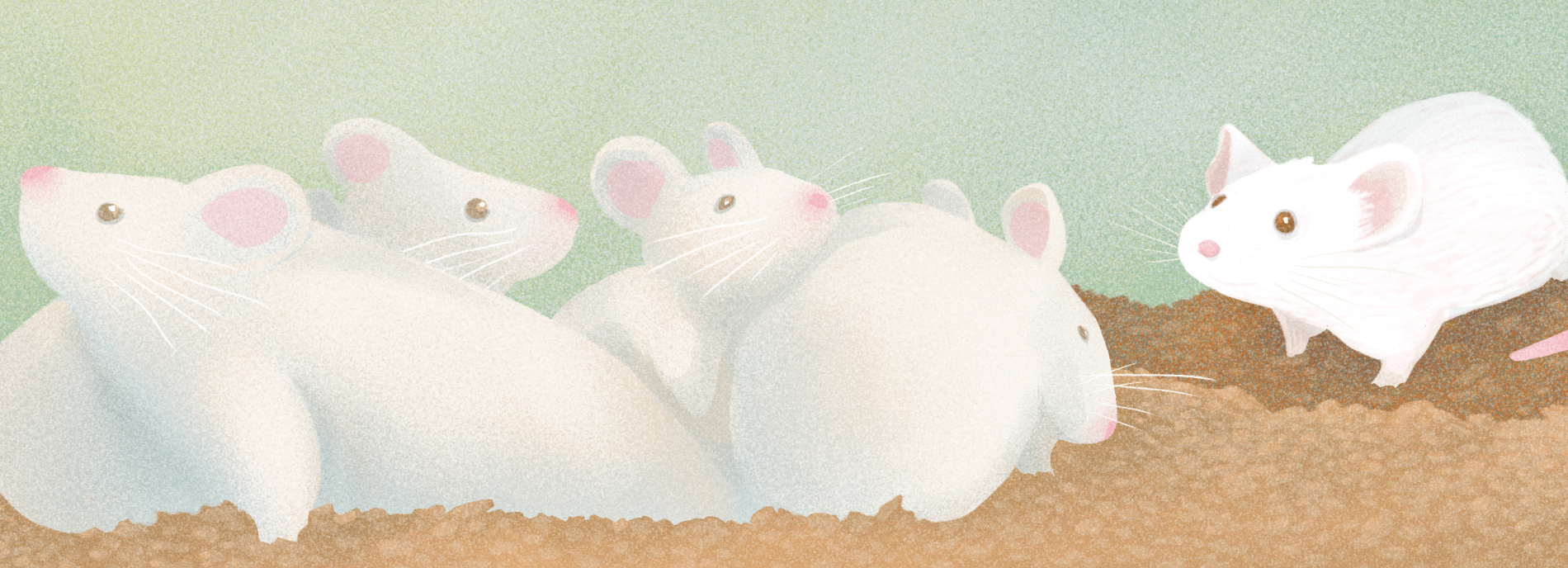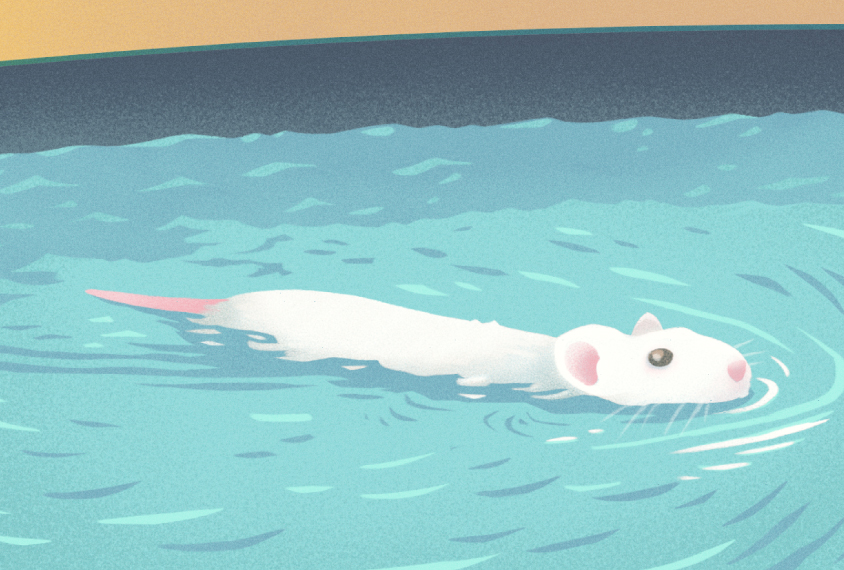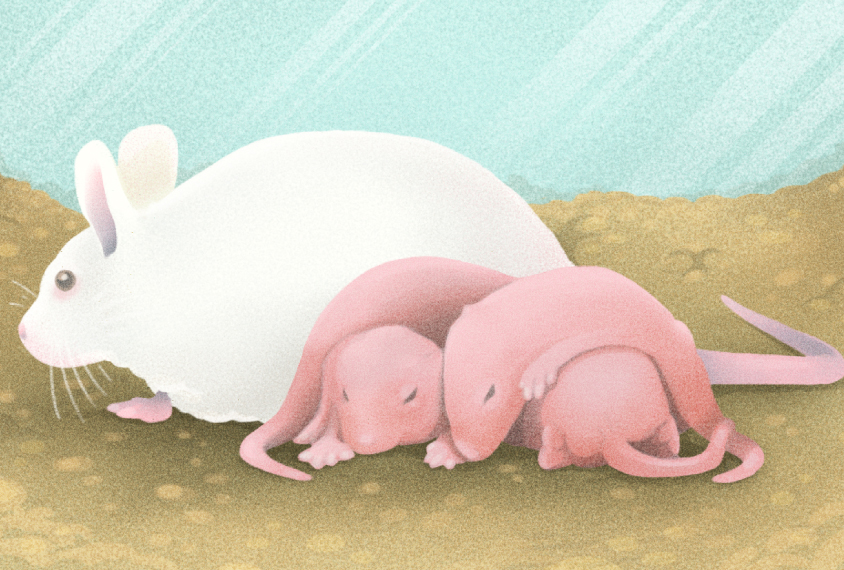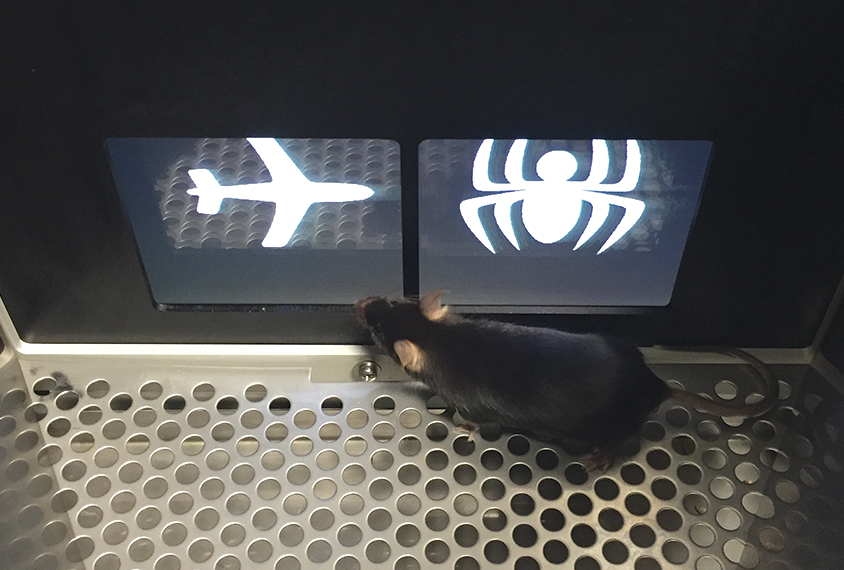Spectrum: Autism Research News
Of mice and women
A new government mandate requires researchers to include females in their animal studies — or explain why they don’t. What will this mean for autism research?

In a lab in Sacramento, California, a wall of plastic boxes lined with corncob bedding holds around 800 mice. Even in this clean and bright room, the smell of so many mice concentrated in one place is overpowering — pungent, and familiar to anyone who has spent time with a pet hamster or gerbil. Most of the boxes hold four adult mice, which flit about, noses twitching as they stare out at the humans staring in. But in one of the boxes, a sleek white mouse is tucked in a corner suckling her litter of half a dozen or so squirmy, dark-furred pups.
In most research labs, the fate of these pups would be determined by their sex. The males would spend their lives as test subjects. The females would either be kept for breeding or simply euthanized because they’re not ideal for experiments: They’re supposedly more difficult to work with and generate less consistent data than males do, and it costs too much to maintain both males and females, which must be housed separately. Or so the rationale has gone.
But these little female pups are different. The lab where they live is run by Jill Silverman and Mu Yang, researchers at the University of California, Davis (UC Davis) MIND Institute. The two scientists study the behavior of about 15 autism mouse models, and they have always included both males and females in their work.
When the pups get older, they will learn to paddle through water mazes or bury black marbles in their bedding, giving researchers insight into how their memory and behavior compare with that of typical mice. Finding the best animal behavioral models of autism is essential because behavior is at the heart of the disorder. In people, autism is diagnosed based on behavioral criteria: abnormal social interactions, difficulties with communication and repetitive actions.
Ideally, these mice should be as much like their human counterparts as possible. Of course, there are limits to how much a tiny, nocturnal rodent can be like a brainy bipedal primate. But if a mouse isn’t the same as a man, a male mouse is even less like a woman, particularly when it comes to the things that define autism. Boys are typically diagnosed four times more often than girls, and autism manifests differently depending on sex; in girls, the disorder is often subtler and more difficult to detect.
“Girls have autism. Maybe it’s not as prominent as boys in the statistics, but girls do have autism and there is significant research that shows that girls with autism have a very different type than boys do,” says Silverman. “So I think females are equally as important to study.”
Silverman and Yang’s research not only includes mice of both sexes, but analyzes their behavior separately. For a long time, this approach wasn’t required, but now others must catch up with them. A year ago, the National Institutes of Health (NIH) rolled out the first phase of a new mandate that requires researchers funded via NIH grants to either include plans for how they will use animals of both sexes or explain why they will work with only one. The hope is that by studying both males and females, scientists will gain better insights into sex differences ranging from behavior to brain anatomy to drug metabolism.
The new rules raise intriguing questions for the field as a whole: Because autism is more common in boys, should researchers use a proportionate amount of resources for studying male mice? Should researchers focus on females in studies that are relevant to Rett syndrome, which primarily affects girls? If scientists begin to include both sexes in each experiment, who’s going to pay for the extra mice?
In order to accommodate this new reality, scientists will need to think more deeply about when sex matters and when it doesn’t. In the year the NIH mandate has been in effect, it has so far changed only how researchers write their grants and plan their studies. “I would say within a few years, it should be possible to start seeing differences in publications,” says Annaliese Beery, a neuroscientist at Smith College in Northampton, Massachusetts, who has been calling for researchers to address sex differences since 2009, and whose work was part of a larger movement that led to the NIH mandate.
The results of those studies may nudge autism research forward in unexpected ways. If autism mostly affects males, understanding the differences between the sexes could explain why, which in turn may reveal something about the fundamental causes of the disorder.
Excuses, excuses:
Historically, women were often excluded from clinical studies because sex wasn’t considered a major factor in health or illness. Even when sex was suspected to be a factor, researchers thought women were too variable to study because of their monthly hormone cycle. They also worried that experimental treatments might harm pregnant women or their babies, especially after the 1960s, when the morning sickness drug thalidomide was found to cause birth defects. “Women of childbearing potential should be excluded from the earliest dose-ranging studies,” asserted a 1977 report from the U.S. Food and Drug Administration (FDA).
That guidance had a chilling effect across all stages of clinical research, notes a 2012 report from the Institute of Medicine: Biomedical researchers were afraid to include women in their studies. What little research women participated in focused on reproduction. For much of the rest, researchers generalized data collected from men to women despite the fundamental differences in physiology, hormones and neurology.
“The underlying assumption is that if you study males, that’s enough and you can extrapolate to everyone else from there,” says Beery. “We’ve seen many examples where that assumption clearly doesn’t hold, where there are really important biological sex differences.”
For example, women have anxiety and depression more often than men do, and they are also more prone to strokes and thyroid disease. Women metabolize drugs differently, too, and are more likely to experience side effects.

Trial by water: The ‘water maze’ probes learning and memory in mice, but how exactly the performances of males and females differ is still unclear.
Among the most infamous examples of this is the insomnia drug zolpidem, marketed as Ambien, which was approved by the FDA in 1992. Many women metabolize the drug so slowly that it is still in the bloodstream the morning after a dose, leaving them too impaired to drive or to do other tasks that require mental acuity. It took more than a decade after zolpidem launched for the FDA to formally address the issue; in 2013, it halved the recommended dose for women.
The women’s health movement — a political force emerging in the 1960s that initially focused on reproductive rights — pushed against the assumption that the results of male-only studies applied equally to women. Activists demanded improved healthcare for all women and an end to sexism in the health system. The NIH officially responded in 1986 with a report acknowledging that women’s health matters beyond reproduction and recommended that both sexes be included in research. In 1993, new rules required that NIH-funded researchers include more women in clinical trials.
Today, more than half of NIH-funded clinical trial participants are women. But in preclinical research — work with animals and cells — the preference for males has remained steadfast. In a 2011 meta-analysis, Beery and Irving Zucker, professor of psychology at the University of California, Berkeley, dug into 10 areas of biological research, such as biology and pharmacology, to see just how bad the sex bias was in animal studies.
What they found is that it was pretty bad: 8 of the 10 disciplines showed a strong bias in favor of males. Their study wasn’t granular enough to analyze autism research, but the most prominent discrepancy it found was in neuroscience, in which studies using only males outnumbered those with only females by more than a factor of five. “And that didn’t even count the studies where they didn’t declare sex in the methods, which probably were often just males,” Beery says.
That lopsided approach may mean that some studies misconstrue the way animals actually behave. Like men and women, male and female rodents have unique sex-based characteristics. In mice, depending on the strain, the sexes may exhibit different levels of anxiety, detected by how willing the animals are to explore new objects or spaces. Females have maternal instincts, whereas males can be aggressive and territorial.
There are also differences in the brain, says Jason Lerch, professor of medical biophysics at the University of Toronto. For example, the bed nucleus of the stria terminalis and parts of the amygdala — brain structures that play a role in social behaviors — are typically larger in male mice than in females. Males and females also have different levels of sex hormones, which affect brain development and function.
The reasons for excluding female animals are familiar: that females’ regular hormonal fluxes during the estrus cycle make their behavior and physiology less predictable, and that this natural variability can make data from relevant tests unreliable.
Those things may be true, but can be accounted for, says Lerch. “We’ve looked explicitly to see how the estrus cycle affects the brain across different stages of the cycle,” he says. “And it does, particularly in the hippocampus, but it’s very subtle.”
A 2014 study from the University of Chicago and the University of California, Berkeley proved the point further. The researchers analyzed 293 scientific articles that looked at a range of traits in both male and female mice at varying stages of the latter’s estrus cycle. They found not only that females are no more variable than males, but that males are actually more variable in certain conditions. The title of the report proclaimed: “Female mice liberated for inclusion in neuroscience and biomedical research.”
“Girls with autism have a very different type than boys do. So I think females are equally as important to study.”
Model behavior:
So far, there are only a few autism studies in which the sex of animals seems to make a difference, but that may be because scientists have only just begun to look.
Some of the most commonly used mouse models of autism are knockout mice, which are engineered so that certain genes are either missing or turned off. These genetic modification techniques debuted in the 1980s, but the first autism knockout mice took a while longer to develop, emerging only in the early 2000s.
To date, researchers have created 676 mouse models that supposedly capture some features of the disorder. No one model is a complete representation of autism, notes Yang. “An analogy would be: None of the instruments in the philharmonic sounds like the symphony.”
Any scientist would also be quick to point out that even the best model mouse does not actually have autism, which is a uniquely human condition. But because mice are naturally social and communicative, and their normal activities — such as how often they groom or play — are well known, those that diverge from the norm are fairly easy to study. Even models that are approximations can be enormously valuable, making it possible to identify biological mechanisms underlying a disorder, or drugs that could help treat it.
In labs such as the one at UC Davis, researchers test the mutant mice for behaviors that might be analogous to symptoms of autism.
One example is the milkshake memory test. At her desk just a couple of floors up from the mouse lab, Silverman pulls up a video on her computer screen. It’s a black-and-white aerial view of a gray mouse sitting in a triangular enclosure, like a surveillance tape from a miniature convenience store security camera. In front of the mouse are two touchscreens flashing simple images — an airplane to the left and a spider to the right. The mouse nudges the spider with its nose, and then scurries to the rear of the enclosure where a trap door opens to reveal a sip of strawberry milkshake.
After the mouse learns which image yields the reward, Silverman says, the researchers can switch the rules, perhaps making the airplane yield the sweet treat. Normal mice can relearn the order of the images, but autism models are usually more hesitant to veer from the original path — reminiscent of the perseverative behavior seen in people with autism. Other behavioral tests examine sociability, giving the mice the choice to spend time either with other mice or with inanimate objects; risk-taking, in which the mice either venture out on to a high open ledge or hide in a dark enclosed space; and repetitive behavior, where the focus is on excessive grooming or jumping.
Silverman calls up a set of raw data from her team’s recent experiments: bar charts comparing sex differences in six different strains of mice across various tests intended to detect behaviors relevant to autism. In this limited dataset, there are no significant differences between the sexes. But that doesn’t mean that sex differences don’t exist, Silverman says.

Next generation: Female mice may help explain why autism can be so different in men and women.
“There are tests that are more sensitive, more sophisticated, that might be able to pick it up,” adds Yang, who is peeking over Silverman’s shoulder. The differences may show up, for example, in more complicated behavioral assays and drug tests, which Silverman and Yang are exploring.
In other labs, some intriguing differences between male and female mice test subjects have already begun to emerge. One example comes from the lab of Sheryl Moy, professor of psychiatry and director of the mouse behavioral phenotyping core at the University of North Carolina’s Carolina Institute for Developmental Disabilities. Moy’s work focuses on the hormone oxytocin, which can be given as a drug to autism model mice and may encourage them to be more social. Her group showed in 2013 that males and females from a strain called C58/J, which has repetitive behaviors and low sociability, do not react the same way to oxytocin. In females, pro-social effects happened sooner and lasted longer. “These results suggest that oxytocin might be particularly effective in females — something we would not have observed just looking at the male mice,” says Moy, who is now comparing oxytocin responses across sexes in other autism models.
Brain imaging research — in which scientists scan tiny mouse brains to understand neuroanatomical differences in autism models — has also revealed sex-based patterns. In 2014, Lerch’s group used magnetic resonance imaging to compare the brains of 26 different autism mouse models to see whether they have common abnormalities. The researchers found that the areas of the brain that are most strikingly different between male and female mice, such as the bed nucleus of the stria terminalis and amygdala, are also areas that are abnormal across many of the 26 mouse models. It’s a strong suggestion that sex differences might be important, says Lerch, although the exact role sex plays is unclear. “These are the things that we don’t know yet,” he says. “But I think we are going to need to understand them to understand autism.”
The issue of sex is particularly acute in preclinical studies of Rett syndrome, a disorder caused by mutations in a gene located on the X chromosome. Boys who have the mutated gene die young, and girls survive, albeit with developmental problems that include features of autism and motor problems that usually get progressively worse as they age. Likewise, male mice with a Rett mutation have much more severe symptoms than the females do, says Zhong-wei Zhang, associate professor at the Jackson Laboratory in Bar Harbor, Maine. Because these severe symptoms develop quickly and are easy to detect, many researchers prefer to work only with the male mice.
This bias may mean that the researchers are missing valuable information about the syndrome, says Huda Zoghbi, professor of neurobiology and genetics at Baylor College of Medicine in Houston, Texas. Because the mutation takes longer to affect female mice, researchers have an opportunity to study how it changes behavior and brain function over the entire lifespan. “There is really a lot of value to studying the females because they have this slow progression of the onset of symptoms,” Zoghbi says, “which is what we see in the human patient.”
Soft money:
The little white mouse mother and her neighbors at the Sacramento lab enjoy unusually nice digs. They breathe air that recirculates 15 times every hour and drink only purified water. Researchers and lab technicians speak in whispers when the animals are running through tests, so as not to disturb them.
The luxury comes at a price. Daily upkeep for one cage, which holds four mice, costs about $1.10. According to Yang and Silverman, a typical behavioral test aims for 20 mice per group in order to achieve sufficient statistical power. Most tests require three groups: controls, genetically altered mice with one copy of the gene of interest, and genetically altered mice with two copies of that gene. That adds up to 60 mice per test. Such tests require more animals than in other areas of research, in part because there are already so many variables that can cause statistical noise in a behavioral experiment — anything from the temperature of the room to whether the handlers are wearing a new cologne.
With the new NIH mandate, that minimum may double in order to get the same amount of data for each sex, because both datasets will often be reported separately (unless there are no discernible differences, in which case the researchers may pool the datasets to boost statistical power). Caging expenses would double, not only because there would be twice as many animals but also because the males and females must be separated so they don’t mate. Given that behavioral tests can take up to two months and mice usually live four to five months in the lab, the mandate’s costs add up quickly.
It’s not clear where researchers will find the money for this extra tab — the NIH hasn’t promised an increase in grant dollars for people trying to fulfill the requirement. “I think it’s great that we’re doing this now, but how does that impact funding?” asks Stacey Rizzo, who teaches a course in characterizing mouse behavior at the Jackson Laboratory. “My colleagues who are applying for grants haven’t seen an increase in the award amounts to compensate for [the new mandate].”

Sweet deal: A female mouse considers her options in the milkshake memory test: The correct choice earns her a few sips.
Jill Silverman
In response to such concerns, Jackson Laboratory scientist Gary Churchill ran hypothetical design scenarios through statistical models to figure out how many more mice an average researcher might need. The calculations included information about the type of test, how much of an effect could be expected, and how variable the responses might be.
Depending on the type of study, some researchers might need twice as many animals, he found. Others might need to add just a few more to their experiments. “The answer depends on the fundamental unknown, which is: In what way do the sexes differ?” he says.
Janine Clayton, director of the NIH Office of Research on Women’s Health, agrees that populations of research mice won’t necessarily have to double. The NIH will evaluate grants not only on whether they include both sexes, she says, but how they consider the ways in which sex affects their research questions and design. “In the long run, money can be saved when scientists study both sexes early in basic and translational science,” she says.
Rat race:
About 20 miles west of Sacramento, Silverman steps into a lab that nearly mirrors her group’s mouse lab, with two notable differences: Everything is bigger, and instead of mice, the lab houses rats.
Historically, mice have been the rodents of choice for autism research, partly because there are so many models representing a broad range of autism-relevant genetic mutations, and partly because they’re small and relatively cheap. But Silverman and principal investigator Leonard Abbeduto began building this lab in 2012 because they say the rat may be a more promising model.
Mice and rats diverged between 12 and 24 million years ago, and the latter evolved to be bigger and more socially complex. Their social behavior could make features of autism — as well as sex differences — easier to recognize in tests.
“See these guys? They’re wrestling and playing,” says Silverman, pointing into a cage where a few white adolescent rats tumble across the floor, taking turns pouncing on one another’s backs. “Mice would never do that. Rats are just way more social.”
Rats are also smarter. Consider the milkshake test: When mice take it, they nudge one touchscreen image or the other with their nose. According to Silverman, rats quickly learn to bypass the rules by hitting both screens simultaneously with their nose and a paw to get their treat. A rat must be given a more advanced version, which includes a small ledge that measures the pressure from its paws, forcing it to use its nose to select one image at a time.
The downside is that rats are more expensive. Originally, Silverman and Baumann planned to use only male rats in their pilot studies because the cost of including both sexes would be substantial; housing and feeding a single adult rat runs to more than a dollar a day.
Ultimately, given the NIH mandate, the researchers decided it made more sense to start the new project with both females and males from the very beginning. Silverman says that is ultimately a good thing for understanding sex differences in autism models. “There wasn’t enough varied behavior [in the mice] to see that difference,” she says. “Now it is closer to being a realistic possibility, because we’ll have a bigger signal.”
She pulls out another plastic cage, occupied by a large white rat with red eyes that is nursing a dozen 21-day-old pups. They’ll soon be weaned and separated by sex into new cages and eventually run in behavior and memory tests just like their smaller counterparts in Sacramento.
How this work plays out at UC Davis and at other autism labs across the country will only reveal itself in time as researchers sort out how to include both sexes and the data start rolling in. But at the very least, it’s time for the sleek white mouse and the big red-eyed rat — and their female pups — to have the chance to show what they’ve got.
By showing how sex differences in autism happen at the most basic level, these animals may change our fundamental understanding of autism. Silverman recognizes that the new policy is going to cost more money — but she says it’ll be worth it. “We should embrace the NIH mandate,” she says. “It’s really important that every one of these models be looked at with males and females separately.”
By joining the discussion, you agree to our privacy policy.